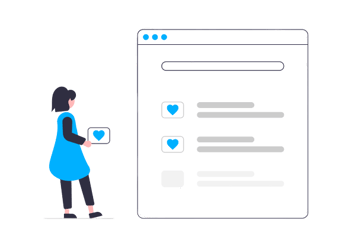Is social media replacing traditional customer service?
There’s no ignoring that social media has taken over our world and the relationship between customers and brands is no different. As it becomes easier for customers to DM or @ a company to complain or give praise does customer service need to adapt and evolve to meet these expectations?
There are several factors to consider here, including your target audience and available resources. Either way, chances are you should be improving your social media customer service, so let’s explore how and why to get started.
What is the relationship between customer service and social media?
Customer service refers to any time a brand responds to a request, complaint, or query. Good service will make the person feel valued and heard, which can significantly impact the overall Customer Experience (CX).
Traditional customer service is provided either in person, by email, or over the phone. For example, anytime a person visits a physical store, they’ll interact with a team member who will help them find what they need or answer any questions they have. However, with the widespread adoption of social media, these relationships are shifting.
Now that social media allows 24/7 contact and instant gratification, shoppers expect to get customer service from wherever they are, and quickly. That’s why it’s vital to be available on social media for your audience to connect with you. Otherwise, they’re likely to turn to a more responsive competitor.
Why do customers prefer social media?
If you can understand what your audience’s motivations are, you’ll be able to adjust your strategy to target them effectively. Right now, social media platforms are the preferred customer service channel for many individuals, and these are the key reasons why:
Simplicity
Consumers are always looking for easy, straightforward solutions to their problems, and for most people, social media offers exactly that. Social media is easily accessible, convenient, and free. Rather than visiting in-store or having a complicated thread of emails, social media makes everything streamlined and hassle-free.
Speed and efficiency
In our fast-paced world, speed is essential, and with the evolution of social media, many functions are available at the click of a button. Social media is designed for quicker response times with real-time notifications and live chat messaging. Not only do these features allow messages to feel more conversational but they also ensure companies can respond sooner.
Consumer autonomy
Social media gives consumers the ability to complete purchases, ask questions, and seek support in a way that suits them. In fact, they can complete most tasks without ever having to leave their homes. Consumers like to feel in control of their decisions and social media allows them to determine who they follow, where they look for information, and how they make purchases. Unlike traditional customer service, this provides a feeling of autonomy and ownership over consumer habits.
Present
Many consumers already spend a proportion of their day on social media. Rather than download a new app or visit a new website they can message a company while they’re interacting or following friends. Being where they are enables brands to reduce the friction in serving their customers.
Tips for customer service on social media
To appeal to more buyers, improve loyalty, and streamline your operations, social media is a must. To help you succeed, here are the core pillars of quality customer service on social media:
1. Empower service teams
Customers will see you as one company on social media. So while the temptation may be to create dozens of spin-off accounts to handle different issues or promote different products the reality is that this should all be handled by one account. This may mean giving customer service team members access to your social media account and empowering them to respond in real time. This is a good thing and will speed up the resolution of issues.
2. Engage in social listening
Being present on social media allows you to take note of what people are saying about your brand, industry, and competitors. This process is called social listening and in doing it, you can understand your customers better, including what motivates them, what will deter them, and how other brands are meeting their needs. To start with social listening, you can set up alerts for brand mentions, follow relevant hashtags, and simply keep track of industry trends. Once you collect the data, you can use the insights from it for marketing campaigns and customer service interactions.
3. Create social media guidelines
When engaging with customers on any platform, it’s best practice to have clearly defined guidelines in place. These guidelines should be readily available to every customer-facing employee and anyone who can access the company’s social media accounts. The purpose of these guidelines is to lay out the tone of voice, the response times for each channel, the protocol for handling negativity, and answers to frequently asked questions. By using this, every team member can provide consistent service across all brand channels, meaning a better Customer Experience altogether.
4. Respond quickly
Remember, customers want fast service. When they post on social media, 79% of customers expect a response from the brand in less than 24 hours, but many brands are failing to meet that demand. The response times aren’t the same across all channels, here’s a list of the most common channels and their recommended response times:
- Facebook response times should be no longer than 30 minutes
- Twitter response times are expected to be just over 30 minutes
- Live chat requires a response in fewer than 48 seconds
- Instagram posts should be responded to within an hour
If you’re not responding to customers fast enough, they’re not likely to wait around. We recommend setting up automation or a chatbot to answer common questions automatically and instantly assign a team member to follow up.
5. Use the right channels
It’s absolutely critical to be available and responsive to customers where they are. Don’t waste time and resources on media platforms that your target audience doesn’t use, instead focus on the channels that customers are actively engaged with already and meet them in that space. Your customers don’t want to waste time and energy to get what they want, so by ensuring your social media channels are aligned with their tastes, you can stay on their radar.
We recommend using social listening and customer feedback to extract insights and meet expectations. There’s no need to guess what your audience wants, instead, ask them directly and deliver relevant solutions more efficiently.
At Review Tui, we use customisable campaign links to track feedback and assess which channels users prefer. This way, feedback isn’t limited to any one channel and as customer preferences evolve, so can your strategy. To improve your customer service on every channel, Review Tui’s Customer Feedback Management software is the perfect tool. With our signature campaign links, real-time analytics, HubSpot integration, and industry advice, our platform does all the hard work for you.
Sign up for our software updates or download our feedback strategy guide to get started.



